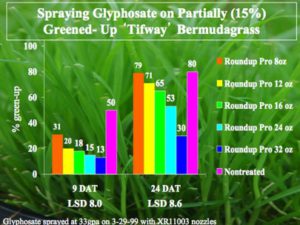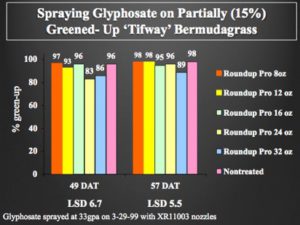Spraying Glyphosate on Slightly Greened-Up Bermudagrass in Winter
go.ncsu.edu/readext?474997
en Español / em Português
El inglés es el idioma de control de esta página. En la medida en que haya algún conflicto entre la traducción al inglés y la traducción, el inglés prevalece.
Al hacer clic en el enlace de traducción se activa un servicio de traducción gratuito para convertir la página al español. Al igual que con cualquier traducción por Internet, la conversión no es sensible al contexto y puede que no traduzca el texto en su significado original. NC State Extension no garantiza la exactitud del texto traducido. Por favor, tenga en cuenta que algunas aplicaciones y/o servicios pueden no funcionar como se espera cuando se traducen.
Português
Inglês é o idioma de controle desta página. Na medida que haja algum conflito entre o texto original em Inglês e a tradução, o Inglês prevalece.
Ao clicar no link de tradução, um serviço gratuito de tradução será ativado para converter a página para o Português. Como em qualquer tradução pela internet, a conversão não é sensivel ao contexto e pode não ocorrer a tradução para o significado orginal. O serviço de Extensão da Carolina do Norte (NC State Extension) não garante a exatidão do texto traduzido. Por favor, observe que algumas funções ou serviços podem não funcionar como esperado após a tradução.
English
English is the controlling language of this page. To the extent there is any conflict between the English text and the translation, English controls.
Clicking on the translation link activates a free translation service to convert the page to Spanish. As with any Internet translation, the conversion is not context-sensitive and may not translate the text to its original meaning. NC State Extension does not guarantee the accuracy of the translated text. Please note that some applications and/or services may not function as expected when translated.
Collapse ▲In North Carolina, application of glyphosate (Roundup, etc) has been a standard treatment for winter weed control in bermudagrass. Typically, glyphosate has been used as a “clean-up” treatment to supplement other pre-emergent or early post-emergent applications for winter weed control. Glyphosate treatment as a clean-up has been a very valuable treatment, not only for weed control, but also helping NC turf managers develop less herbicide resistance to other herbicides such as sulfonylureas, triazines, etc.
Glyphosate is registered for weed control at 1 pint/acre on dormant bermudagrass. Application of glyphosate in winter is highly efficacious if applied during warm winter days (great than 60 degrees). On warm days, glyphosate uptake is greater due to more easy penetration of the herbicide via the waxy leaf cuticle. In addition, glyphosate efficacy is enhanced when applied a low spray volumes (less than 50 gpa, but 20 to 30 gpa is preferred).
There have been many days this winter where daytime temperatures have been favorable for glyphosate application. In fact, that is just the problem. The warm and sunny days have resulted in premature green-up of bermudagrass. Hence, the most common question I have received this winter: “how much damage can I expect from glyphosate application on slightly greened-up bermudagrass?”
The first thing I remind turfgrass managers is that you will not kill bermudagrass with 1 pint/acre of glyphosate even if applied in July. However, you will see injury. So the question is, how much injury will you see if glyphosate is applied now, on a sunny 70-degree day with slightly green bermudagrass? Several years ago, I did a study on this topic with glyphosate application on slightly greened-up ‘Tifway’ bermudagrass. In this study, I estimated ‘Tifway’ bermudagrass to be approximately 15% greened-up.
The chart below follows green-up following various glyphostate rates applied to 15% green bermudagrass. Ratings were recorded at 9 DAT (days after treatment) and 24 DAT. Note that at 9 DAT rating, the nontreated bermuagrass was already 50% greened-up whereas 1 pt/a of glyphosate was 18%. By 24 DAT, bermudagrass was 65% greened up with 1 pt/a of glyphosate whereas the nontreated was 80% greened-up.
The bottom chart follows green-up at 49 and 57 DAT. Note that the labeled rate of glyphosate (1pt/a) had caught up to the nontreated and was no longer delayed. By 57 DAT, all rates of glyphosate except the 2x rate of 1 quart/acre were as green as the nontreated plots.
Summary:
Spraying glyphosate on slightly greened-up bermudagrass will delay green-up. More green-up at application equals more delay in green-up. However, in my research, bermudagrass has not been permanently injured. A delay in green-up similar to the labeled rate of glyphosate in this test, is likely not going to be noticed by golfers, homeowners, or those that utilize sports fields. However, it is recommended that the area be uniformly sprayed (instead of spot sprayed). A uniform delay in green-up is much less noticeable than irregular green-up that results from spot spraying.





